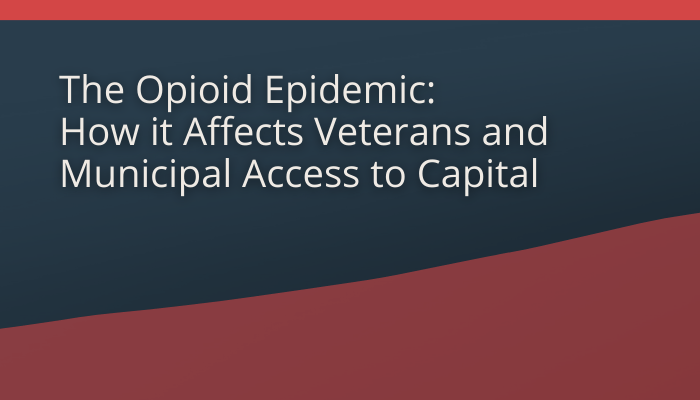
Physical trauma incurred in the line of service often has long-lasting implications on veterans' well-being and quality of life. In fact, the VA health system reported that one-third of its veterans have chronic pain. In addition to physical pain, many veterans face barriers to their mental health that puts them at risk for a myriad of issues including an increased risk for substance abuse and addiction. The prevalence of chronic pain in conjunction with the increased risk of substance abuse has made the veteran population particularly susceptible to the opioid epidemic; while the veteran population has suffered directly from the effects of opioid painkillers, the epidemic’s impact on municipal access to capital poses an additional long-term threat to veteran well-being.
Background on the Opioid Epidemic in the United States
The opioid epidemic has plagued the United States for approximately 30 years. Starting in the late 90s, pharmaceutical companies propagated the mass distribution of opioid medications by marketing them as a low-risk, non-addictive, and highly effective option for pain management. Though there was no evidence to back the claims that these drugs were non-habit-forming, doctors started prescribing medications like OxyContin indiscriminately. Many patients were prescribed an opioid medication when alternative forms of pain management would’ve sufficed or were prescribed dosages that were unnecessarily high. Due to the highly addictive nature of opioid painkillers, which share a similar chemical composition to heroin, overdose rates skyrocketed. While the U.S. government has since taken active steps to limit the number of opioid painkillers prescribed, and the public has become wise to the addictive nature of these drugs, issues persist.
How the Opioid Epidemic Has Affected Veterans Directly
Opioid painkillers were prescribed to many veterans to treat chronic service-related pain; many veterans were also given opioid prescriptions to help manage symptoms related to Post Traumatic Stress Disorder (PTSD). Dependency and opioid-related overdoses amongst the veteran population far exceeds that of the general population, and in 2012, one in three veterans were prescribed an opioid painkiller.
The federal government has taken strides to reduce the number of opioid prescriptions; in a 2020 report, the Department for Veteran Affairs announced that since 2012 prescription opioid use had decreased by 64%, the number of veterans prescribed opioid and benzodiazepines had decreased by 87%, and the number of high dosage opioid prescriptions had decreased by 80%.
Though the reduction of prescription opioids reported by the VA reflects steps in the right direction, these numbers fail to reflect the continued dependency on opioids in the veteran community and beyond. Many patients who had been prescribed and developed a dependency on an opioid painkiller have turned to heroin or synthetic opioids like fentanyl when access to prescriptions became more limited.
After the implementation of the VA’s Opioid Safety Initiative (OSI) in 2013, which drastically reduced the number of opioid prescriptions, there has been a sharp increase in the number of veteran suicides and non-prescription opioid overdoses, particularly in rural communities where there’s less access to mental health and substance abuse treatment.
Ask AVG how they can help you support the well-being of veterans in your community
The Opioid Epidemic’s Impact on Municipal Access to Capital and Long-Term Implications for Veterans
Beyond the immediate and direct threats the opioid epidemic poses to veterans’ health, there are more subtle consequences that can affect their long-term well-being, namely the impact the epidemic has had on communities’ access to municipal capital.
In order to address the continued dependency on non-prescription opioid abuse and addiction, communities need mental health and substance abuse treatment programs. However, as the Principles for Responsible Investment reported, the communities with the highest need are least likely to get the support required to eradicate the very issue that’s precluding them from funding.
The Principles for Responsible Investment found counties with high levels of opioid abuse:
- Have a high demand for capital, but struggle to find investors
- Have annual interest costs approximately $300,000 more than those in low-abuse counties.
- Miss out on approximately $15 million in annual funding due to lower issuance amounts of new municipal debt.
When we consider the opioid epidemic and veteran health and well-being, we need to expand our thinking beyond the immediate and direct threats these substances pose. If we are dedicated to supporting veterans’ health in the long-run we need to consider policy-based changes that support municipalities struggling with these issues.


